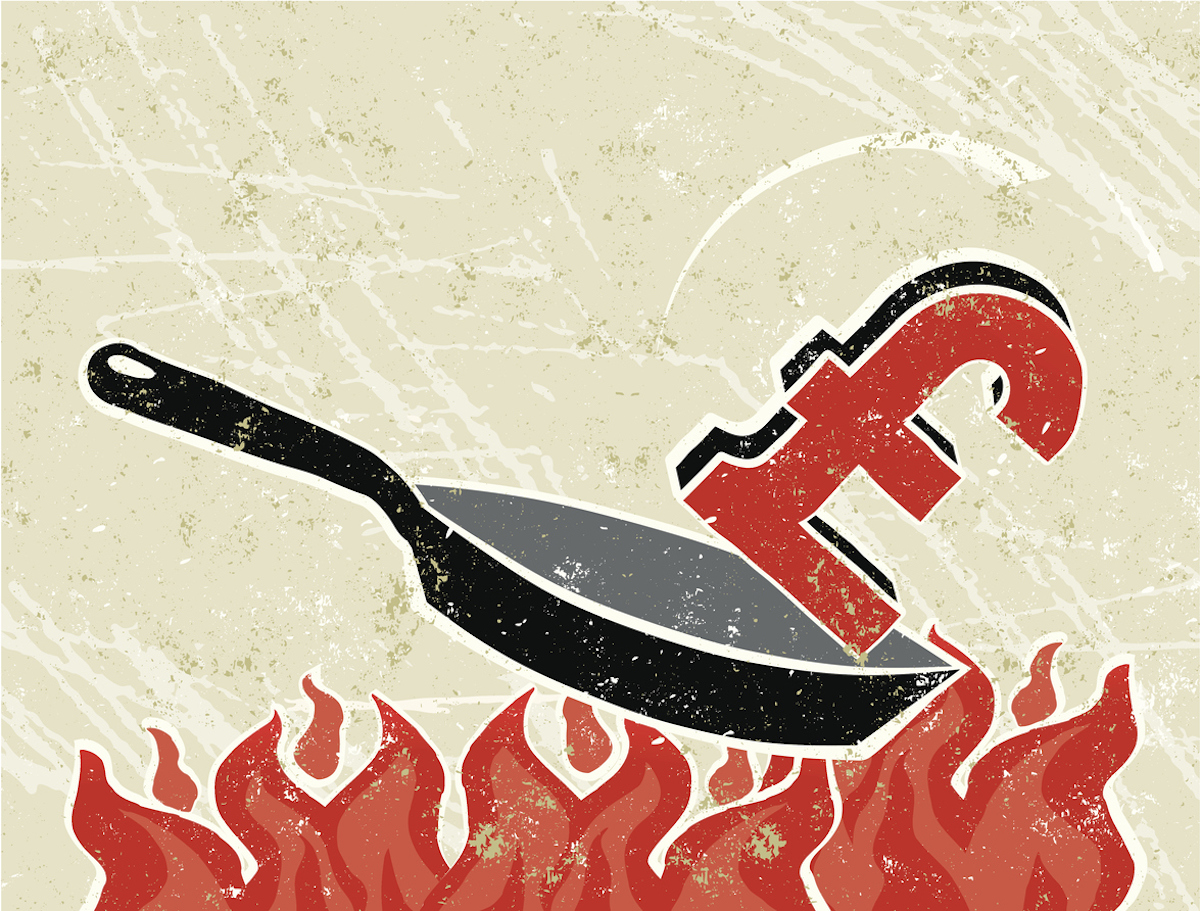Soaring prices and staff and supply chain shortages: how the food and drink sector can mitigate risks

The food and drink industry faces rising costs everywhere it looks, from ingredients to operations. How bad is the situation, and how can it mitigate the risks that lie ahead?
Energy prices
When it comes to the risks faced by food and drink, the spiralling cost of energy dominates. Though the Government stepped in with a support package on the 21st of September, introducing a “supported wholesale price” the new PM says will cut bills by half the amount they were predicted to be this winter, it’s an indication of just how steep those predictions were that they will still be double the amount businesses paid in 2021. The support is also set to last for six months and what happens after that is uncertain. As relations between Russia and the West continue to deteriorate, it’s unlikely anything will have dramatically improved by next summer. There is no doubt the world of business appreciates the support on offer, but the Government’s intervention is a postponement of the energy crisis rather than a solution to it.
Hospitality businesses are among those wincing at the increase in energy prices, including Fuller’s, which runs 178 inns and 15 hotels. Announcing its latest set of results last week (sales were up 50% for the first half of the year compared to last year) Fuller’s CEO Simon Emeny said in terms of energy-related risk, he expects Fuller’s total bill for gas and electricity in the current year to be £18m compared to £8m the year before. He describes the increases as “unsustainable” and says “despite having proactively purchased forward contracts [for energy] to limit the impact on Fuller’s, we will see significant increases this year.”
And, of course, it’s not just hospitality feeling the strain, it runs much deeper throughout food and drink down to production itself. The cost of energy is “one of the biggest pressures affecting the entire supply-chain” says Jaz Singh, CEO and founder of Innovation Agri-Tech Group. “Increased farm-gate pricing has eased it to an extent, but costs continue to surge with the very likely outcome that those increased prices will not reflect true production costs, which then impacts on commercial viability.”
The rising cost of energy is also by no means the only risky situation ahead. “We are faced with unprecedented inflation across the board, a turbulent geo-political landscape, climatic extremes, and a severe shortage of labour,” says Singh.
Staff shortages and supply chain disruption
A recent initiative to combat staff shortages and encourage young people and jobseekers into the industry is the Food and Drink Industry Careers Passport. Developed by the National Skills Academy for Food and Drink (NSAFD) and the FDF, with support by the over 50 food and drink companies (including Mars, Britvic and Coca Cola) the passport equips entry-level candidates with accreditation in Food Safety Level 2, HACCP Level 2, Health and Safety Level 2 and Allergens Awareness. The Welsh Government has already rolled out a nationwide pilot of the scheme that’s seen 500 people sign up (it’s also being tested in six prisons).
Singh also says the sector “must also be ready for increased pricing as well as more shortages of some core ingredients and staples.”
When it comes to pricing, according to the most recent figures released by the FDF, food price inflation is at 13.1% – the highest since 1989 and the second highest figure on record.
As for shortages, gaps on supermarket shelves are becoming a familiar sight due to availability issues. As well as fresh produce scarcity, largely due to Brexit, the UK is also seeing a number of ingredient shortages, such as sunflower oil, which it imports from the largest producer in the world, Ukraine. In March it was revealed manufacturers of popular products like crisps, breaded fish, frozen vegetables and chips were swapping out sunflower oil for refined rapeseed oil – which makes no material difference to the end product, but led to the FSA advising consumers to exercise caution (though it also said allergic reactions to rapeseed oil are “very rare and – if they do occur – are mild”). Also in March, Iceland was forced to return to using palm oil in some own-label products (it stopped for environmental reasons in 2018) because of the soaring price of sunflower oil. CEO Richard Walker described the move as “strictly temporary” and said the only alternative would be to “clear our freezers and shelves of a wide range of staples including frozen chips and other potato products”.
Food and drink is planning for future risk where it can. Milk & More, owned by dairy giant Müller, is well placed to comment on the various issues facing the industry, from the price of basic ingredients to the price of energy. It describes itself as the UK’s largest e-commerce farm shop on wheels and operates using a combination of fresh produce from small localised suppliers, which it delivers to 400,000 households via a fleet of 500 electric vehicles, operating from 50 fulfilment centres across England. It makes over one million deliveries every week.
CEO Patrick Müller says “As seen across the industry, our costs have increased significantly over the last year. Milk has risen by 72% and renewable electricity costs by 199%. We have also experienced a significant rise in the cost of reusable glass bottles, which we use for 91% of all our milk deliveries. When Müller first purchased Milk & More at the beginning of 2016, a one pint glass milk bottle cost 6p, since then prices have tripled and in the last year alone grown by 33%.”
In an attempt to mitigate these increases, Müller says Milk & More is “working to reduce our energy use and make our bottles more durable, aiming to reduce our bottle usage by 500,000 annually, down from 3.5 million, which represents just over a 14% decrease.”
Another business concerned with the rising price of bottles and product to fill it with is the wine trade. In the wake of the mini-budget, Wine and Spirit Trade Association CEO Miles Beale says he’s happy with the “laudable freeze to alcohol duty”, but he’s less than enthusiastic about the “pound tanking against the dollar” which has delivered a “significant blow for UK wine businesses and consumers.” He says: “99% of the UK’s wine is imported and one fifth of all bulk wine imported to the UK and bottled here, is US wine. The sterling crash is set to raise prices for consumers and threaten hundreds of British jobs in bottling plants across the UK.”
Despite the freeze to alcohol duty, he says the Government’s planned changes to the way it taxes wine means that from 1 February 2025 “all wine will be taxed according to strength, which will see a further increase in duty for almost half the still wines sold in the UK. Even if alcohol duty rates were frozen for 2.5 years, changes to the way duty is calculated will see a US Zinfandel at 14% abv, for example, increase by at least 22%, adding an extra 60p per bottle.”
He says, for wine, “costly catastrophes” await. “Rather than allowing businesses to grow and add to the economy, the Government’s plans will do the complete opposite.”
Like Müller, Beale also points to the rising price of glass, describing it as an “international issue”. He says the UK has seen glass prices “increase by over 30%” adding to the pressure caused by “continuing supply chain problems, increased production costs due to the price of energy and other inflationary pressures. The clear conclusion is there is little sign of the prices going down any time soon.”
Mitigating rising costs
Mitigating rising input costs by looking for potential efficiencies, however small, to make any operation as lean as possible has been underway across the industry for many years. But recent pressures have increased the urgency. The City Pub Group also released positive results last week, but also “streamlined” its food and drink menus and undertook some “menu engineering” to minimise costs and prices, similar to the famous example of American Airlines, which removed one olive from each salad it served to passengers in the 1990s and reduced annual costs by $40,000. It’s a good micro example of driving efficiencies from an operational perspective. But on a macro level, Singh suggests the breadth and scale of the risks ahead for food and drink demands producers adopt a holistic rethink to cut costs, long before the food ends up on a plate in a pub.
“As an industry, we need to step outside the box, explore new options and re-think how we approach food production to mitigate the risks,” he says. “Investment in emerging technologies such as AI, robotics, and precision farming will enable growers to increase output.”
Widespread adoption of future tech, including “novel food production systems” like vertical farming, would also “alleviate the pressure on other issues such as labour shortages. If at the same time we can speed up cost-effective on-farm green energy solutions, such as solar or wind, the risks across the food and drink industry could be reduced.”
Before then, with winter fast approaching, the unpredictable climate is a constant risk to anyone digging up basics like root vegetables up to those bottling recherché red wine. Efforts to predict and protect against the weather are increasingly sophisticated, but little can be done to effectively negate extreme weather altogether for anyone growing on hundreds of acres of land. Many food and drink businesses are also still shedding the lingering effects of COVID and Brexit remains far from ‘done’. Labour shortages are common as a result. Singh says what was already a “perfect storm” for primary food producers becomes “even more turbulent when you think about sourcing the labour to harvest the crops that you can grow”. He believes food security, a catch-all terms for the widespread availability of food, is now a “very real factor for the entire food and drink industry”.
There are reasons to be optimistic about the immediate future. Fuller’s CEO Simon Emeny points to the “first restriction-free Christmas for three years” and the first ever Winter World Cup, which should see pubs even busier than usual over the festive period. That’s despite the ongoing cost-of-living crisis – another risk which is expected to continue to impact on discretionary consumer spending, like meals out, and it’s expected to get worse with predictions of a recession getting stronger.
And though the Government has taken action over energy, the longstanding issue of high business rates remains. “With just six months to go before the next revaluation, businesses still have no idea what their rateable values will be,” says John Webber, Head of Business rates at Colliers. “With no clarity about how much they will be expected to pay in their rates bills come April, how can businesses be expected to plan sensibly ahead?”
New FDF CEO Karen Betts summed things up at the beginning of September, telling MPs it was looking like it was going to be a “really difficult winter” for food and drink. Long-term it’s hard to imagine it will be anything but for a while to come.








